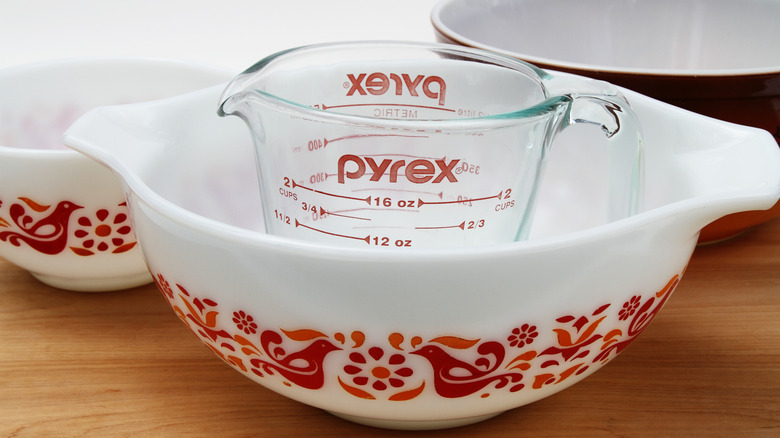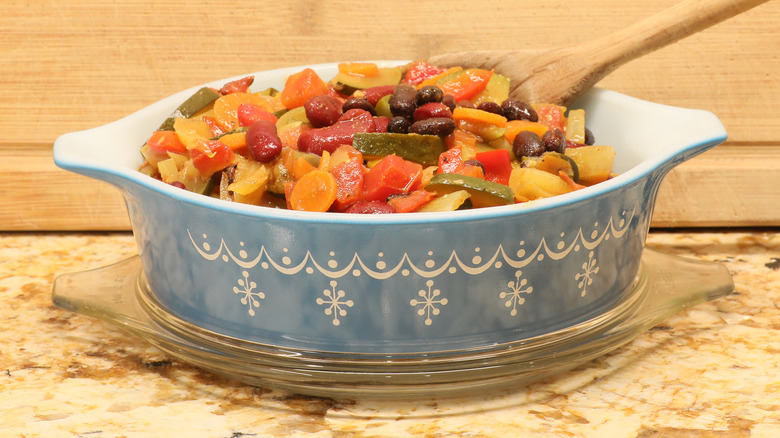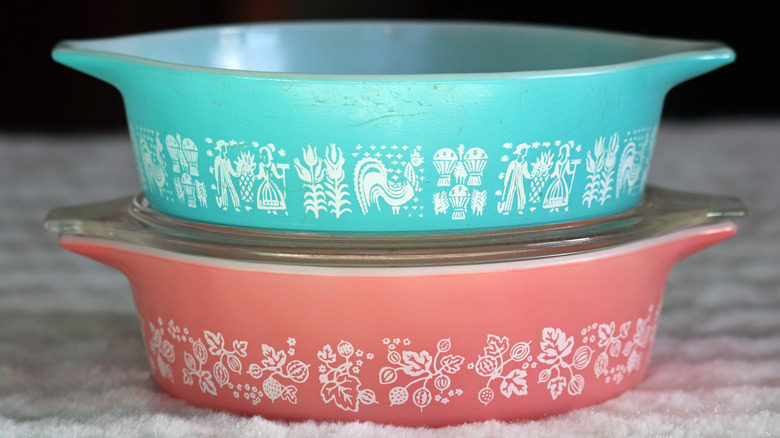Here's What Those Numbers On The Bottom Of Your Pyrex Dishes Mean
Glass cookware is super-common in American kitchens, and it all started with the brand Pyrex. This heat-safe glass cookware was originally created in Corning, New York, in the early 1900s, and it's been a staple for home cooks for generations.
While most of the Pyrex in today's kitchens are everyday, clear glass casserole dishes and liquid measuring cups, there are many serious collectors in search of rare pieces. They're so dedicated that they'll even get vintage Pyrex patterns tattooed. One of the ways that collectors know what to look for is the three or four-digit number codes pressed into the bottom of each piece. If you've ever flipped over your pie plate or casserole dish and wondered what all those numbers are about, they're simply product codes that are assigned to each style and size of dish. If you're thinking about collecting, or you just want to identify a stash of pieces you inherited, it's a good idea to get to know Pyrex's somewhat secret model number codes.
The model numbering system evolved over the decades since Pyrex first came into existence, but, to this day, there is one useful tip to remember when you're reading a code: The last number in the code almost always corresponds to the volume capacity of the dish. The trick, however, is to know which series of Pyrex you're using.
Model numbers and volume
A lot of recipes will tell you exactly what size pan to use, but it's almost always expressed in inches. For example, brownies are often baked in a 9 x 9 pan. You can either reach for a ruler or measuring tape, or do what a lot of bakers do and memorize the dimensions of your hands to do a quick measurement. There are a lot of times when you need to know the volume of the pan or bowl, however, which is not so obvious. This is when a Pyrex model number comes in handy, as long as you know how their model coding system works.
If you want to identify your Pyrex volume by the model number, the last digit of the model number tends to indicate the number of pints or quarts, but the numbers are not universal, so you need to know which series you're using. For regular mixing bowls, for instance, the model numbers are 401 (1½ pint), 402 (1½ quart), 403 (2½ quart), and 404 (4 quart). Bake Serve and Store casseroles, on the other hand, are numbered 471 (1 pint), 472 (1½ pint), and 473 (1 quart). The Pyrex Collector maintains a handy list of common model numbers if you're not sure what you've got.
Model numbers are important to collectors
Today, almost everyone has seen a Pyrex piece, but in the early 1900s — when borosilicate glass was invented – it was quite the innovation, and they became must-have items in millions of kitchens. Tastes in home decor have changed since the first Pyrex hit the market, so you don't see old patterns in stores anymore, and many were broken or thrown away over the years, so any early pieces that survived are valuable. If you're interested in collecting or selling old Pyrex, you can tell a lot about a piece by its model number.
It's not often that you'll find complete sets of vintage Pyrex for sale in a vintage shop or on the internet, so a serious collector will know the model number series of the set (or sets) they're trying to complete. They'll also know that the model number will appear on both the dish itself and the cover so that they can make an exact match. Typically, if a piece has a cover — which most do — the model number will be followed by a "B" for the bowl or "C" for the cover.
So, if you're ready to start identifying grandma's old casserole dish collection, the first step is to study all of the model numbers so you know what you have. And if you're not looking to sell, at the very least, you'll know exactly how much potato salad your pieces can hold. Just don't call it Anchor Hocking.


